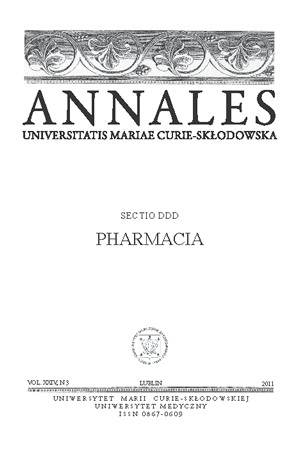Application of isobolographic analysis for the evaluation of interactions between bioactive constituents from dandelion (Taraxaci flos) and lime (Tiliae flos)
DOI:
https://doi.org/10.12923/Keywords:
Isobolic analysis, dandelion, lime, phenolic compounds, lipoxygenaseAbstract
Reactive oxygen species (ROS) have been implicated in more than 100 diseases. In living organism ROS can be formed eg.with lipoxygenase (LOX) action. In this study the LOX-inhibitory activity and phenolics profiles of dandelion and lime flowers tinctures were compared and the interactions between them were evaluated using an isobolographic analysis. Dandelion flowers tinctures were a good source of phenolic acids, whereas lime flowers tinctures were better source of quercetin, kaempferol and apigenin. Higher LOX inhibitory activity was obtained for dandelion tincture (IC50 about 36.4 mg d.m./ml) whereas for lime tincture IC50 average about 46.4 mg d.m./ml. Isobole curve for 50% inhibition of dandelion : lime flowers mixture took the convex form. This result indicates that LOX inhibitors of studied preparation acted antagonistically.
References
1. Aguirre-Hernández E et al.: HPLC/MS analysis and anxiolytic-like effect of quercetin and kaempferol flavonoids from Tilia americana var. Mexicana. J. Ethnopharm., 127, 91, 2010.
2. Axelroad B, Cheesborough TM, Laakso S: Lipoxygenases in soybeans. Methods Enzymol. 71, 441, 1981.
3. Gawlik-Dziki U. Świeca M: Effect of various pH conditions simulated in vivo on the activity of lipophilic antioxidants isolated from selected spices. P Jour Food Nutr Sci., 57, 19, 2007.
4. Hu C, Kitts, DD: Antioxidant, prooxidant, and cytotoxic activities of solvent-fractionated dandelion (Taraxacum officinale) flower extracts in vitro. J. Agric. Food Chem. 51, 301, 2003.
5. Juntachote T, Berghofer E: Antioxidative properties and stability of ethanolic extracts of Holy basil and Galangal. Food Chem., 92, 193, 2005.
6. Kirakosyan A et al.: Interactions of antioxidants isolated from tart cherry (Prunus cerasus) fruits. Food Chem., 1, 78, 2010.
7. Leung AY, Foster S: 1996. Dandelion root. In: Encyclopedia of Common Natural Ingredients Used in Food, Drugs and Cosmetics, second ed. John Wiley & Sons, New York, pp. 205, 1996.
8. Sadik CD, Sies H, Schewe T: Inhibition of 15-lipoxygenases by flavonoids: structure-activity relation and mode of action. Biochem. Pharmacol., 65, 773, 2003.
9. Schewe T: 15-lipoxygenase-1: a prooxidant enzyme. Biol. Chem. 2002. 383. 3-4. 365–374.
10. Singleton VL, Rossi JA: 1965. Colorimetry of total phenolics witch phosphomolybdic-phosphotungstics acid reagents. Am. J. Enol. Vitic., 16, 144, 1965.
11. Toker G et al.: 2004. Flavonoids with antinociceptive and anti-inflammatory activities from the leaves of Tilia argentea (silver linden). J. Ethnopharm., 95, 393, 2004.
12. Ulrich-Merzenich G et al.: Synergy research: Vitamins and secondary plant components in the maintenance of the redox-homeostasis and in cell signaling. Phytomed.: 16, 2, 2009.
13. Williams CA, Goldstone F, Greenham J: Flavonoids, cinnamic acids and coumarins from the different tissues and medicinal preparations of Taraxacum officinale. Phytochem. 42, 121, 1996.
14. Williamson EM: Synergy and other interactions in phytomedicines. Phytomed. 8, 401, 2001.
15. Yildirim A et al.: Comparison of antioxidant and antimicrobial activities of tilia (Tilia argentea Desf ex DC), sage (Salvia triloba l.), and black tea (Camellia sinensis) extracts. J. Agric. Food Chem.: 48, 5030, 2000.
Downloads
Published
Issue
Section
License
Copyright (c) 2011 Author

This work is licensed under a Creative Commons Attribution-NonCommercial-NoDerivatives 3.0 Unported License.


